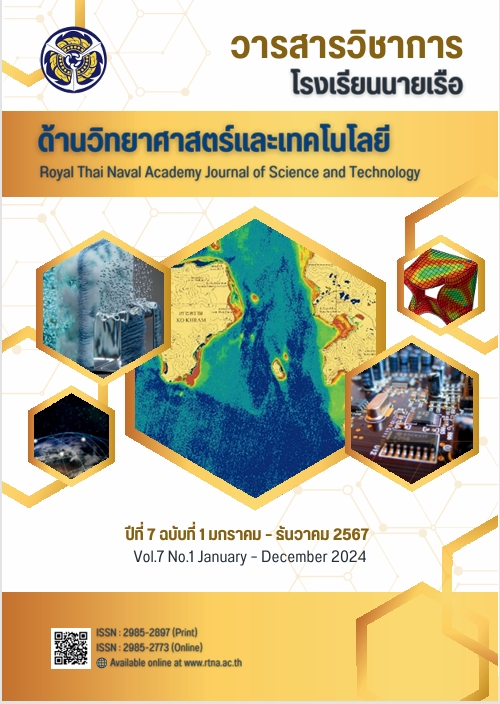Survey and Analysis of Caffeine Content in Caffeinated Beverages Sold in Chulachomklao Royal Military Academy
Main Article Content
Abstract
Beverages containing caffeine are highly popular nowadays, as evidenced by the proliferation of coffee shops in various communities. It is important to consume caffeine in moderation, ideally not exceeding 400 milligrams per day to avoid adverse health effects. This research aims to investigate the consumption behavior of caffeinated beverages sold in 4 coffee shops in Chulachomklao Royal Military Academy. The study sample consists of 316 cadets and instructors from the academy. The caffeine content in the beverages was analyzed using UV-visible spectrophotometry. The survey results revealed that 96% of the sample consumed at least one caffeinated beverage per day, with popular choices being cappuccino (28%), espresso (20%), americano (17%), latte (11%), mocha (8%), cocoa (8%), green tea (5%), and Thai tea (3%). Upon analyzing the caffeine content, the results revealed that the caffeine content in the coffee shop beverages at the academy ranged from 14.49 to 183.35 milligrams per serving. The beverages with the highest caffeine content per serving were the 5 types of coffee: cappuccino, espresso, americano, latte, and mocha, ranging from 121.49 to 183.54 mg. Following those were Thai tea with 122.47 to 135.05 mg, green tea with 101.31 to 110.09 mg, and cocoa with 14.49 to 17.61 mg, respectively. Therefore, the recommended consumption limit for coffee and Thai tea from these coffee shops at the academy is not more than 2 cups per day, while for green tea, it is not more than 3 cups per day.
Article Details

This work is licensed under a Creative Commons Attribution-NonCommercial-NoDerivatives 4.0 International License.
The author has the sole responsibility for the material published in RTNA Journal of Science and Technology, which the editorial board may not agree on that material.
RTNA Journal of Science and Technology owns the copyright of the text, the illustration, or other material published in the journal. No parts or the whole of the material published may be disseminated or used in any form without first obtaining written permission from the academy.
References
Amare M, Shimelis A. Polymer modified glassy carbon electrode for the electrochemical determination of caffeine in coffee. Talanta 2012; 93:122-128.
ปัทมา ตาปราบ. การศึกษาการสื่อสารทางการตลาดและลักษณะของผู้บริโภคกาแฟสด [การศึกษาค้นคว้าอิสระ ปริญญาโท สาขาการตลาด]. ขอนแก่น: มหาวิทยาลัยขอนแก่น; 2551.
Norton TR, Lazev AB, Sullivian MJ. The ‘Buzz’ on caffeine: patterns of caffeine use in a convenience sample of college students. Journal of Caffeine Research. 2011; 1(1):35-40.
ศิวพร ไวทยะพิศาล. พฤติกรรมการบริโภคกาแฟสดของบุคลากรสายวิชาการ มหาวิทยาลัยเทคโนโลยี ราชมงคลพระนคร [วิทยานิพนธ์ปริญญาคหกรรมศาสตรมหาบัณฑิต]. กรุงเทพฯ: มหาวิทยาลัยเทคโนโลยี ราชมงคลพระนคร; 2560.
Chaugule A, et al. Extraction of caffeine. International Journal of Advance Research in Chemical Science. 2019; 6(9):11-19.
. ณัฐนิช อินทร์ขำ. ข้อดีของการดื่ม “กาแฟ” ที่มี “คาเฟอีนธรรมชาติ” [อินเทอร์เน็ต]. กรุงเทพฯ: สำนักโภชนาการ กรมอนามัย; 2565 [เข้าถึงเมื่อ 1 พ.ค. 2567]. เข้าถึงได้จาก: https://nutrition2.anamai.moph. go.th/th/rrhlnews.
Gaza U. A comparative analysis of caffeine extraction efficiency from different tea varieties and its effect on human physiology: a spectrophotometric investigation. American Journal of Analytical Chemistry. 2023; 14:134-148.
ไพรัตน์ โชควิบูลย์กิจ. การวิเคราะห์ปริมาณคาเฟอีนในเครื่องดื่มโคล่าโดยวิธีการสกัดและสเปกโตรโฟโตเมตรี. วารสารเทคโนโลยีการอาหาร มหาวิทยาลัยสยาม. 2548; 1(1): 40-44.
Murray SD, Hansen PJ. The extraction of caffeine from tea: an old undergraduate experiment revisited. Journal of Chemical Education. 1995; 72(9):851-852.
Saad M, et al. Determination of caffeine content in coffee drinks prepared in some coffee shops in the local market in Jeddah city, Saudi Arabia. Open Chemistry. 2023; 21:1-7.
Gebrewold F, Geletu G. Chemistry of caffeine in coffee and its determination using uv/vis spectrophotometer: a review article. Chemistry and Materials Research. 2018; 10(1): 23-27.
Ihsan BRP, et al. Determination of caffeine in robusta coffee beans with different roasting method using uv-vis spectrophotometry. Food Research. 2023; 7(6):29-34.
Amen A. Determination of caffeine content in some commonly consumed tea brands in Taraba state. International Journal of Modelling and Applied Science Research. 2022; 25(9):165-174.
Vuletic N, et al. Spectrophotometric determination of caffeine content in the selection of teas, soft and energy drinks available on the Croatian market. Food Research. 2021; 5(2):325-330.
อาดุล อับดุลลอ. การวิเคราะห์ปริมาณคาเฟอีนในเครื่องดื่มปรุงแต่งด้วยช็อกโกแลต โดยวิธีใช้ 1-โพรพานอลเป็นสารสกัดด้วยเทคนิคสเปกโทรโฟโตเมตรี [วิทยานิพนธ์ปริญญาวิทยาศาสตรบัณฑิต]. กรุงเทพฯ: มหาวิทยาลัยเทคโนโลยีราชมงคลกรุงเทพ; 2551.
ทิพยรัตน์ ชาหอมชื่น และคณะ. ประสิทธิภาพของวิธีการสกัดโดยคลื่นอัลตราโซนิคต่อปริมาณคาเฟอีนและฤทธิ์ยับยั้งแบคทีเรียจากกากกาแฟ. วารสารสถาบันวิจัยและพัฒนา มหาวิทยาลัยราชภัฏบ้านสมเด็จเจ้าพระยา. 2566; 8(2):61-71.
Eticha S, Bedassa T. Determination of caffeine in coffee samples by high performance liquid chromatography and ultraviolet-visible spectrophotometry methods from Wollega, Ethiopia. International Journal of Biochemistry, Biophysics and Molecular Biology. 2020; 5(1): 8-17.
Grujic-Latic N, et al. Quantitative determination of caffeine in different matrices. Macedonian Pharmaceutical Bulletin. 2016; 62(1):77-84.
Misto KA, et al. Spectrophotometric analysis of caffeine in local product of arabica: observed at different roasted temperatures. IOP Conf. Ser.: Mater. Sci. Eng. 2021; 1173: 1-7.

